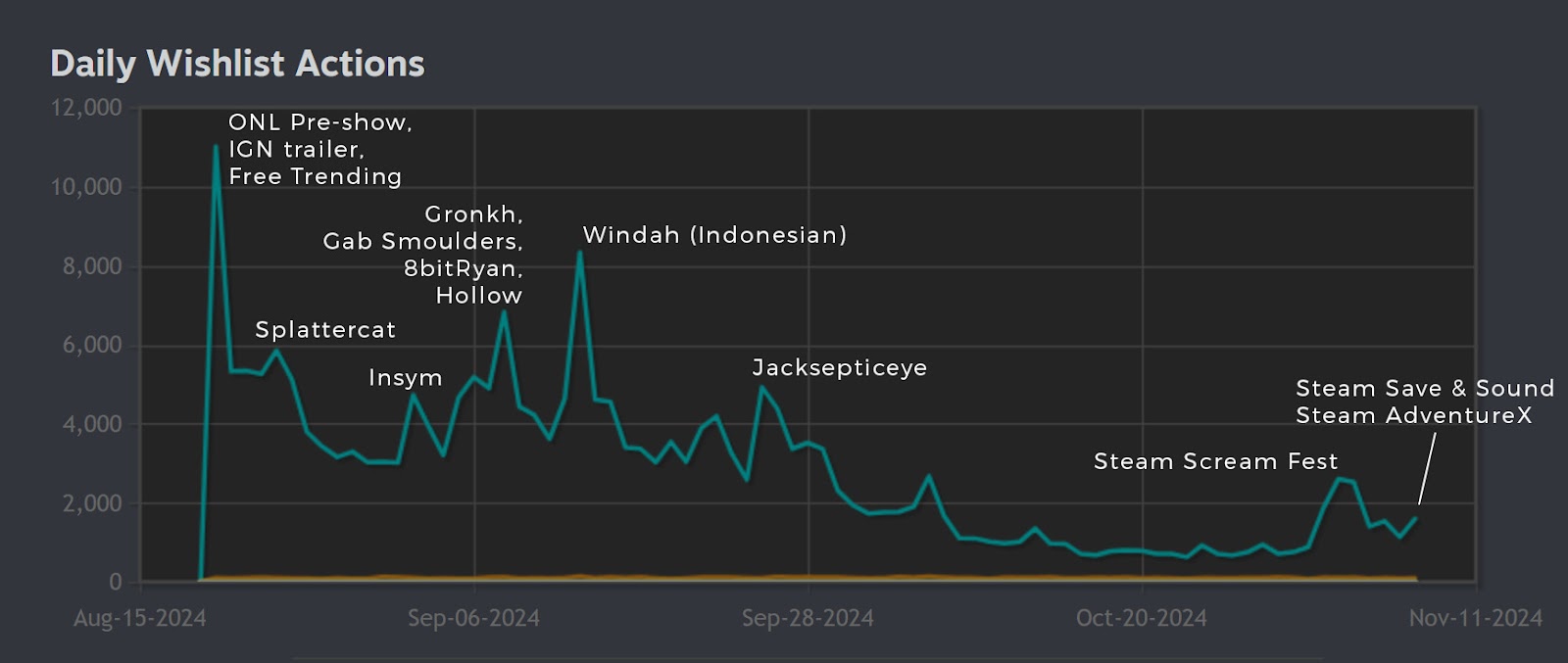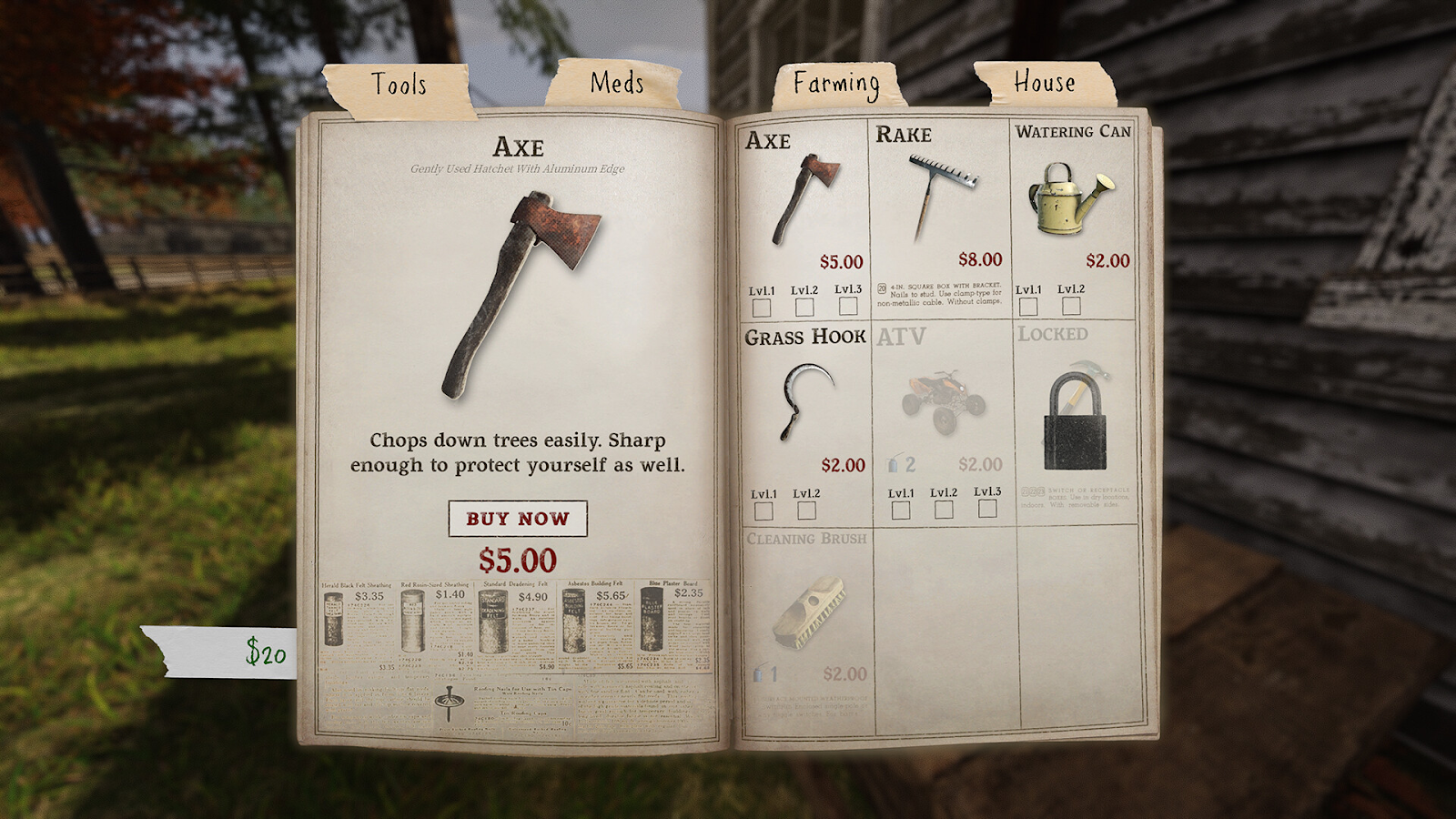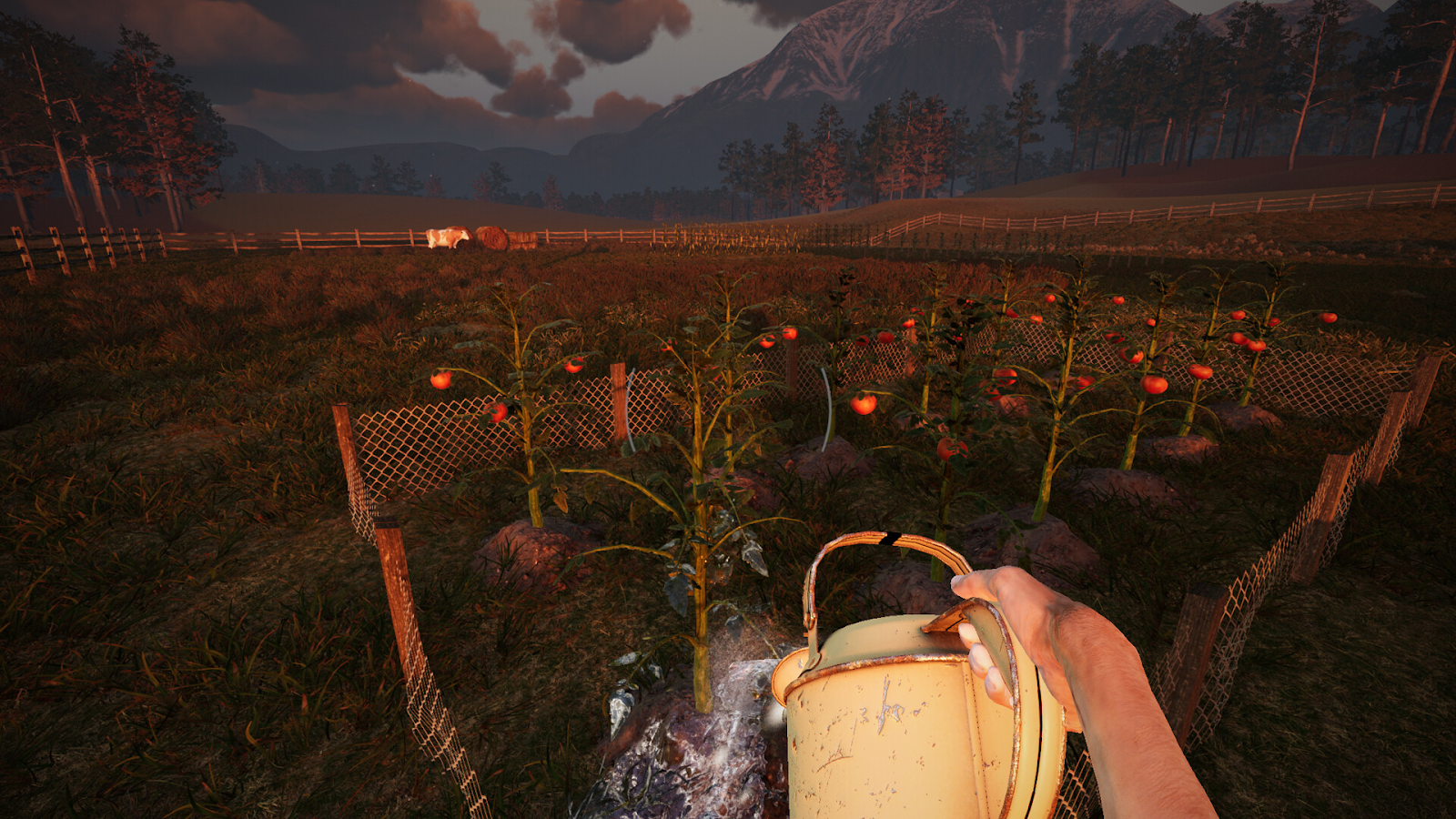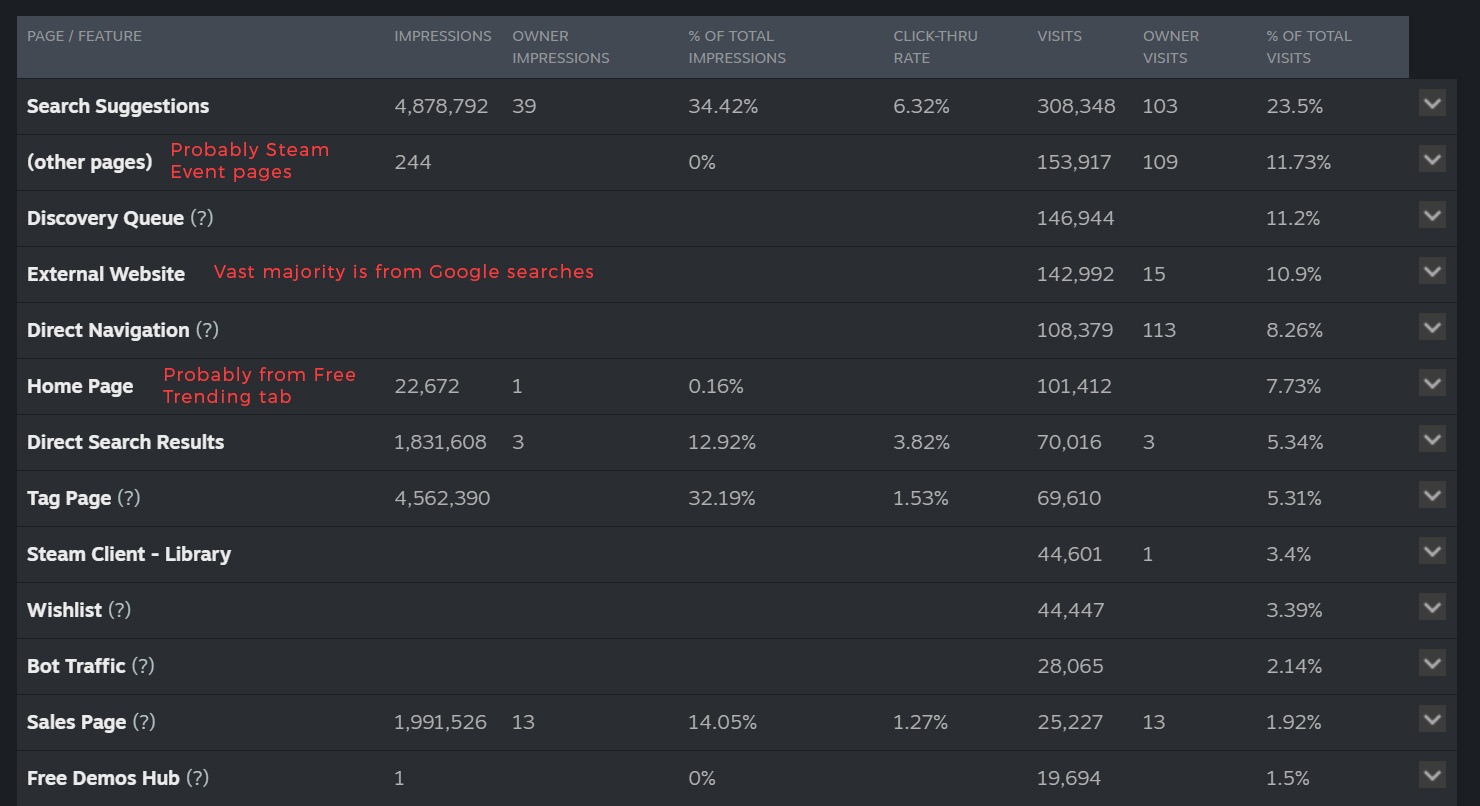
Here is the wishlist graph for We Harvest Shadows where solo developer David Wehle managed to earn over 220,000 wishlists using a trailer, a demo, and some clever marketing:

How did he do it?
- Make a game in a popular genre: Horror + First Person work-sim
- Release many games and learn from the experience (some successful, some not so much)
- Big cataclysmic announcement: Launch a demo + Gamescom Opening Night Live + IGN Trailer featuring
- Ride the Discovery Queue traffic that resulted from step #3
- Ride the front page “New & Trending Free” tab to get Streamers to play the demo
- Keep the demo up forever and continue to ride the content creator coverage
- Enter into as many festivals as possible.
- Typical wishlists earned in one week with no big promotions: 4,200
- Store page impressions: 14.17 million (9.17% clickthrough percentage)
- Store page visits: 1.3 million (5.9% conversion rate)
OVER ANALYSIS WARNING: I am including the conversion rate here because I want to remind people that it is a meaningless stat that fools people into over-analysis. (See the appendix at the bottom for an explanation as to why you should stop looking at conversion rate)
Market-driven approach to finding novel games
We Harvest Shadows is a next generation narrative game. For a while if you were an indie developer looking to make a story-rich first-person game you could do ok with a walking simulator (like Dear Esther or Gone Home). Eventually narrative games evolved to include more and more interaction and almost puzzle elements (Firewatch or What Remains of Edith Finch)
But puzzle games just don’t sell as well as other genres such as Simulation or Horror. David analyzed the market and saw that first person simulator games (typically made by the publisher Playway) were incredibly popular but typically lacked a strong narrative. David added a narrative focus to the Simulation genre and found a very potent combination.
How did he discover this?
“I have a habit of checking Steam trending charts pretty often (and also itch.io when I can), and I noticed that usually the more popular indie games were non-fantastical, work-sim type games. I think players like relaxing by completing short repetitive tasks and getting that dopamine hit of checking stuff off your to-do list, like Animal Crossing! I’d also played The Mortuary Assistant by Brian Clarke and The Convenience Store by Chilla’s Art, and really enjoyed them, and noticed that focusing on preparing deceased bodies or mopping the floor distracted you from the hauntings, which made it actually more terrifying since your mind would get a “horror reset” after getting distracted with your work. After playing hit games like PowerWash Simulator, House Flipper, and of course Farming Simulator, I thought it would be fun and interesting to add the hauntings and the emotional story elements to that type of gameplay. It was a game I personally would’ve loved to play, and I thought people would like it too… and I was right thankfully!”
David
CZ Analysis:
Seriously, horror is hot and every indie should make at least one horror game.
When I write about what genres are popular (what genre is popular in 2022) (more what’s popular) (Secret genres) I am not saying I think you should “copy” or “clone” those hit games. I am not saying to go trend chasing. Instead, I am trying to show you the types of games the Steam audience is hungry for and they enjoy playing.
As a creative designer and innovative indie, it is good to use this marketing research as a jumping off point. Start from the genres I point out are popular, then see where you can bend the genre. What can you add that hasn’t already been there? What can you take away from the game and still maintain that core interest that the audience finds so compelling?
David did exactly that.
Doing work-sim chores and crossing off a to-do list is a compelling gameplay loop. An interactive story is interesting to players. Why not stretch the work-sim genre to include a story?
Similarly, David has clearly played a bunch of games from the genre such as The Mortuary Assistant and The Convenience Store. Play the games, deconstruct them, see what makes them successful and see what you can innovate on.
David looked at what was popular now, anticipated where things were going, then used his good taste and experience to create a game that is on the cutting edge of indie games. This is not “copying” or “cloning” or “trend chasing” it is being aware of the culture and where it is going.
Demo content
David is keeping the We Harvest Shadows demo up indefinitely but you should play it right now. It is the perfect encapsulation of how to make a demo for a Narrative game: give just enough content to excite players but not so much that they feel like they don’t need to buy the game, and end on a cliffhanger.
What was his design approach?
I mostly wanted to hit that 1 hour of median demo playtime so I could hit that upper-tier you talk about in the Benchmark series, but more importantly, I wanted to give players an exact feel on what the full game would be like.
That means cinematic song sequences, enemies, scripted events, animal AI, secrets, cutscenes, etc. If a player tried the demo, they would have a great sense of what the final game would feel like, so I had to add a little bit of everything, which was a ton of work!”
- David
The Median playtime for We Harvest Shadows is 1 hour 7 minutes which is at the top tier of games I surveyed.
CZ Analysis: Graphics attract, but gameplay sells
This quote from David is key:
I had noticed that some games with over a 100,000 wishlists were sometimes still not selling well, which freaked me out, so I figured that a great demo would help players know if it was a game they would actually buy. Not every game needs to be made for everyone, but for people that like these specific things, I needed to convince them that it was their type of game and get them excited.
What David is describing is the secret superpower of demos: they reduce risk. A game that has truly beautiful graphics or an interesting concept can go viral with just a tweet or a trailer and it can generate 100k wishlists. BUT it might be an illusion. If the game has janky controls, or simplistic gameplay, or bugs, players will get turned off as soon as they buy it. Bad word of mouth will lead to poor conversions.
Graphics attract, but gameplay sells.
Releasing a demo protects you from being surprised if your wishlists don’t convert. To determine whether your demo is successful, check my benchmarks page for median playtime. Also I recommend you use the Steam option to host the demo on a separate Steam page so that players can leave reviews. It might be painful to see complaints, but better to learn about them at the demo stage than during the full launch.
Demos boost wishlists
The [Opening Night Live] show lit the fuse, but it was a polished, localized demo and the Steam algorithm which really made it pop off.
David
As proof, David pointed to A.I.L.A as a benchmark. A.I.L.A is also a horror game with amazing graphics, it also was announced on Opening Night Live. However, it did not have a demo at the announcement.

A.I.L.A has one-fifth as many wishlists as We Harvest Shadows.
David’s demo amplifies a good launch and allowed him to get content creator coverage.
When to push the notify wishlister button
Valve added a new feature where anytime during the first 2 weeks after the launch of your demo you can notify all wishlisters that the demo is live. When should you push it?
Should you push it on the day when your demo launches when you are trying to fire every promotional tool at the same time (but have few wishlists)? Or push it 2 weeks after the announcement and remind the people who wishlisted it that that the demo still exists?
David pushed the button at the end of the 2 weeks.
“I announced my game in the pre-show stream of gamescom Opening Night Live, so I figured that in the excitement of that day, a lot of people would wishlist it then forget to play the demo, so I waited the max two weeks after announcement day and hit the button. I think it helped a tiny bit”
- David
He said that the “Demo Release Notification Email” traffic was 1.27% of my total store traffic.
I think it was the right call to push it when he did, but even with that it wasn’t a whole lot of traffic considering. Don’t over-analyze this decision.
Content creator coverage
David got a bunch of content creator coverage from the biggest in the industry: Splattercat, Insym, Jacksepticeye. How did he get it?
“I asked them how they found my game. I had sent a few emails to content creators and assumed they found it through that, but no one said they read my emails! They didn’t even hear about it from Opening Night Live! It was all from the Steam Free Trending tab. I think these big YouTubers usually browse Steam regularly for new, cool looking games that their audience might like. I thought that maybe they would have employees that forward them emails from devs or suggest things, but I think it’s all just them browsing for fun. I still think smaller to medium-sized content creators can be reached through email, but the big guys will independently self-select what they think is cool.”
CZ Analysis:
All hail the Steam algorithm. That front page featuring exposed David’s game to content creators.
A good Steam page with a good capsule that shows off your game in the best light, which leads to content creators. If your steam page accurately shows off your game’s features that signal that it is in the popular genre that it is (you are making it in a popular genre right?) then content creators will look at it more. They will say “YES, my audience loves simulation and horror! This looks like it will do well.”
Look at his steam page screenshots, they just scream “first-person simulation-y work games” (which is a very popular genre among content creators). If David tried to be more coy with the genre and focused on the narrative elements, and hid the UI elements (like the item catalog pictured below), I don’t think they would have been as eager to play.
If you need help making a steam page I have a free class here: howtomakeasteampage.com


How to get into big showcases
A big event like PC Gaming Show, or Geoff Keighley’s Game Awards can cost tens-of-thousands of dollars. Not a reasonable amount for most indies.
BUT, if your game is interesting, and you have a proven track record, many organizers will let you in for free because they want to support interesting indies.
David got in for free, here is how he did it:
“I basically sat on my trailer and announcement for well over a year just waiting. I was getting tired of waiting so I was going to announce regardless, but I knew I had one more shot with Geoff Keighley’s last big show of the summer, Opening Night Live in Germany. I checked out the info pamphlets for the Indies of America booth in the Indie Hall, which is sponsored directly by gamescom and isn’t a mediator like the Indie Arena Booth. I noticed on page 4 that you have an opportunity to be “integrated” into their big shows, so I signed up for the booth, talked to my booth manager, and she gave me Geoff Keighley’s email!
So it was a lucky cold outreach. I think how I worded my email to Geoff helped a lot too. They love indie games of all kinds, but these are multi-million dollar productions, and they need to be assured that these editorial placements will truly excite the audience. In my email, I talked about my previous game’s success, my YouTube channel’s success, and why I thought the game would go big, which I think helped, but mostly he just loved my trailer.
I worked really hard on that trailer for months, and I made it specifically for a big show like this. Even though the show was an amazing, lucky experience, I think my game would’ve still done well if I was in a smaller show, because the vast majority of my wishlists have been from content creators, bar none.
David
IGN Trailer featuring
If you have an interesting game in an interesting genre you can get the IGN Youtube channel to host your trailer.
How do David get the featuring? He did exactly what I outlined here.
To get a contact over at IGN he just looked through recent IGN articles for indie games and saw who wrote them. Then found that person’s email address (it was listed on her twitter bio). Contacted her with a pitch and mentioned that he was featured in Geoff Keighley’s Opening Night Live as social proof. Intrigued, she forwarded it to the right people at IGN who manage the youtube channel.
They negotiated a 24-hour exclusivity deal for a longer cut of the trailer that didn’t fit in the Opening Night Live spot.
That trailer got 290,000 views.
CZ Analysis
Reread the steps David took to get into Opening Night Live and the IGN trailer. David was like a private investigator who worked hard to track down the contact information for the right gate keeper who could grant him entry into their garden of millions of viewers. This is the most underrated marketing skill. It is a secret skill that not enough indie developers appreciate. It is a skill that is not public like a spicy meme-filled tweet. Marketing is not sending tweets. Marketing is going down a hundred blind alleys that lead nowhere until you find that right person. Marketing is tracking down the right person who can give you visibility, showing them your cool thing, convincing them (nicely) why it is cool, and then letting them share your game with their audience. Marketing is making a human to human introduction not trying to game some algorithm to get a 1% improved click-through-rate.
Even if you have a well made game in the right genre you can’t just wait around and hope the right person finds you. You have to reach out there and shove it (nicely) in their face and ask for shit.
This is what marketing a game looks like. It is not sending off another tweet that like 4 people see.
Discovery Queue
You aren’t paying enough attention to the Discovery Queue (DQ). The DQ is the bonus for doing amazing marketing. It is the amplifier. It is how the Steam algorithm promotes you. It is why you give Valve 30% of your sales.
After content creators, the DQ was the largest driver of wishlists to We Harvest Shadows.
Here is the total traffic graph for the game and DQ. Note that on August 20th was when the game was announced, the Gamescom show, and the launch of the demo.
Then 3 days later, the DQ woke up.

I have reported before on what it takes for the DQ to wake up pre-release.
To trigger the DQ David got
- 11,010 wishlists on August 20th
- 5,322 wishlists on August 21st
This far exceeds the 3583 wishlist median I found in my survey.
The DQ is mysterious though. I have seen games earn more than 3500 wishlists yet never trigger it. My hunch is that Valve features the top performing games of the day. I suspect that there are other games that were featured in the Gamescom event that earned 3500 wishlists but didn’t get into the DQ. We Harvest Shadows was probably one of the top performers so earned the DQ slot.
So think of 3583 as the baseline to make you competitive, but it also matters what other games are trending.
Summary
Here is the traffic breakdown for We Harvest Shadows (Red notes from David)

What do we learn from this:
Search Suggestions, External Website (Google), Direct Search Results are all from Gamescom and Content Creators. People see the trailer or a streamer playing it and say “ooh that looks interesting” and then use Google search, or go to the Steam client search box and enter the game’s name.
Discovery Queue is Valve blessing the game with traffic after so much came in externally.
Home Page, and Tag Page is the demo getting into New & Trending free. The Tag page also has a “Top Demos” and trending sections so that drove it too.
To sum up the strategy
- Make a game in a genre that has real momentum on Steam and pair it with a unique hook
- Track down and show your game to people who have big audiences so that they will share it with them. Use a trailer to get Geoff Keighley and IGN to cover you. Use a demo to get content creators to cover you.
- Use the traffic from step #2 to trigger the Steam algorithm and have Valve show your game to their audience.
David’s Experience
David Wehle has been around long enough and made some really interesting games that he is an important voice you should follow.
He gave this great GDC talk for his game The First Tree.
He is running a sale right now on his course that teaches you some of what he did. Check it out here
Appendix: Conversion rate doesn’t matter
The more visibility Steam gives you (which is good) the lower your conversion rate is (which doesn’t matter). I wrote about conversion rate benchmarks here.
As you can see in the following chart, the games that get tons of wishlists typically have conversion rates in the low 10% range. The low-performing games have much higher conversion rate (20%-50%).
So repeat after me “Conversion is a meaningless stat, conversion is a meaningless stat…” Instead of focusing on how to improve your conversion rate, focus on getting your demo out faster, reaching out to the right people who have a big audience, and getting Streamers to play it.
